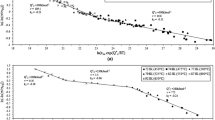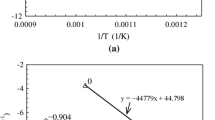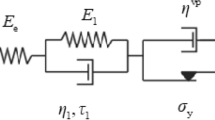Abstract
Experimental evidence is produced to corroborate the theory that creep of wood can be divided into two parts: a ‘primary’ or short-term part, and a ‘secondary’ or long-term part. The primary part was completed within one to two days. The secondary part followed a straight line on a plot of creep against logarithm of time, thus simplifying long-term creep prediction from short-term data. In addition to the carefully-controlled experiment described here, the analysis was applied to eight-year creep data published by Gressel, who also supplied numerical values. Alternative prediction methods by Hunt were based on a ‘normalising procedure’. Most of the predictions for the eight-year tests came within a few percent of the measured value, and were generally conservative. It was not possible to confirm whether the secondary creep is likely to follow the straight line indefinitely, or whether the rate decreases eventually towards a viscoelastic creep limit.











Similar content being viewed by others
References
Casagrande S, Castera P and Morlier P (1997) A simple method for evaluating the creep limit in lumber. COST E8 International conference on wood-water relations, Copenhagen, Denmark
Gressel P (1984) Zur Vorhersage des langfristigen Formänderungsverhaltens aus Kurz-Kriechversuchen. Holz Roh Werkst 42:293–301
Gril J, Hunt D (2001) Analysing wood creep at constant moisture using phase diagrams. In: Navi P (ed) Proceedings of the 1st international conference European society for wood mechanics, Lausanne, Switzerland, 19–21 April
Hanhijärvi A, Hunt D (1998) Experimental indication of interaction between viscoelastic and mechano-sorptive creep. Wood Sci Technol 32:57–70
Huet C (1967) Représentation des modules et complaisances complexes dans les plans complexes arithméthique et logarithmique. Cah Groupe Fr Rhéol 5(1):237–258
Hunt D (1986) The mechano-sorptive creep susceptibility of two softwoods and its relation to some other materials properties. J Mater Sci 21:2088–2096
Hunt D (1991) A creep limit in wood? Cost 508 workshop on fundamental aspects of creep in wood, Lund, Sweden, pp 1–19
Hunt D (1999) A unified approach to creep of wood. Proc R Soc Lond A 455:4077–4095
Hunt D, Darlington M (1978) Accurate measurement of creep of nylon 6,6 at constant temperature and humidity. Polymer 19:977–983
Hunt D, Gril J (1996) Evidence of a physical ageing phenomenon in wood. J Mater Sci Lett 15:80–82
Hunt D, Gril J (1998) Comparison between juvenile and mature wood in the analysis of creep. COST E8 conference, Florence
Mohager S, Toratti T (1993) Long term bending creep of wood in cyclic relative humidity. Wood Sci Technol 27:49–59
Toratti T (1991) A study on the existence of a creep limit using available test results. Cost 508 workshop on fundamental aspects of creep in wood, Lund, Sweden, pp 20–26
Van der Put T (1989), Deformation and damage processes in wood. Delft University Press, Delft, p 70
Acknowledgement
The author wishes to thank J.M. Leban of the Centre de Recherches Forestières de Nancy for supplying the European spruce used in this work; also Peter Gressel of the Fachhochschule Rosenheim and Preben Hoffmeyer of the Technical University of Denmark for supplying data for study and presentation.
Author information
Authors and Affiliations
Corresponding author
Rights and permissions
About this article
Cite this article
G. Hunt, D. The prediction of long-time viscoelastic creep from short-time data. Wood Sci Technol 38, 479–492 (2004). https://doi.org/10.1007/s00226-004-0244-6
Received:
Published:
Issue Date:
DOI: https://doi.org/10.1007/s00226-004-0244-6




